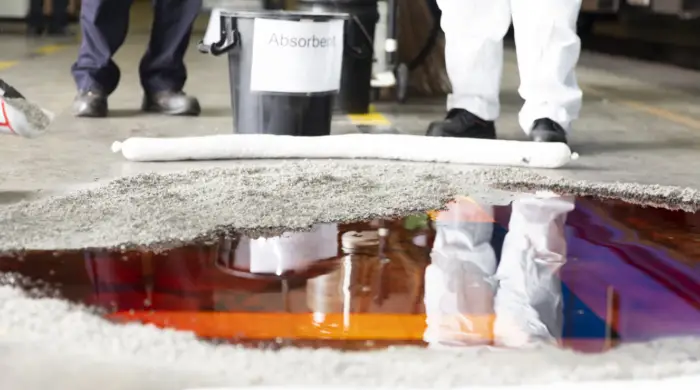For professionals that work with chemicals, the hazards faced on the job are multiple and dangerous.
While not all chemicals may be toxic or present the same level of danger, there is a sufficient number in numerous industrial settings to warrant extreme prudence when choosing appropriate protective gear.
Chemicals pose health dangers as they can be the cause of injuries and illnesses, some life-changing as well as fatalities in worse case scenarios.
Other side effects of working with chemicals include allergies, asthma, skin conditions or injuries, asphyxiation, reproductive repercussions, chemical burns, and even birth defects.
We asked a team of professionals who work with chemicals daily to help us research and test the best chemical-resistant work boots.

Our team voted overwhelmingly for the Timberland PRO Powerwelt Men’s Wellington Work Boots as the best overall chemical-resistant work boot. This work boot from Timberland’s PRO series not only protects but affords comfort while doing so.
Another work boot that received high ratings is the Honeywell Servus Xtp Chemical-Resistant Men’s Knee Boot. Injection-molded seams in PVC use triple-density technology for exceptional waterproofing and protection from degradation due to some chemicals. Outsoles feature an open pattern tread for self-cleaning affording excellent traction.
| Work Boots | Uppers | Outsoles | Safety | Waterproof | Construction |
|---|---|---|---|---|---|
| Timberland PRO Powerwelt Men’s Wellington | 100% Leather | Rubber | Steel toe, ASTMF2412-18a, EH | Waterproof | Goodyear Welt Cast-Bond |
| Honeywell Servus Xtp Chemical-Resistant | PVC | Rubber | Steel shank | 100% waterproof | Injection molded PVC |
| Muck Boots® Chore Slip, Oil, and Chemical-Resistant | 5mm neoprene | Rubber | Steel toe, ASTM F2413-11 | 100% waterproof | – |
| Wolverine Overpass Men’s Six-Inch | Leather and Textile | Rubber | Composite toe, ASTM F2413-11, EH | Waterproof | Contour welt |
| Carhartt CMF6366 Men’s Six-inch | Leather | Rubber | Composite safety toe ASTM 2413-18, EH for 18,000 volts or less in dry conditions | Water-resistant | Welt cement |
Our Favorite Best Chemical-Resistant Work Boots
Best Overall Chemical-Resistant Work Boots
1. Timberland PRO Powerwelt Men’s Wellington Work Boots
- Color-blocked work boot with mid-high shaft featuring pull-on construction and aggressive tread design
- Boot opening measures approximately 15 around
- Shaft measures approximately Mid-Calf from arch
- Rubber sole
- 100% Leath
Prices pulled from the Amazon Product Advertising API on:
Product prices and availability are accurate as of the date/time indicated and are subject to change. Any price and availability information displayed on [relevant Amazon Site(s), as applicable] at the time of purchase will apply to the purchase of this product.
This work boot from Timberland’s PRO series not only protects but affords comfort while doing so. Contoured open-cell polyurethane insoles cushion feet on hard surfaces.
Fingertip pull-on loops facilitate getting boots on and off without touching the actual boot upper. Outsoles are dual-density polyurethane that is slip-resistant guaranteeing traction and steel safety toes protect feet from impact injury.
The construction is ideal for resisting chemicals thanks to the Goodyear Welt Cast-Bond method to prevent seepage and chemical entry.
Pros
-
-
- Steel safety toe caps
- Goodyear Welt Cast-Bond construction method
- 100% Ever-Guard leather uppers are heat-resistant
- Loops for easy pulling on or off
- Antimicrobial treated fabric lining
- Steel shank
- Aggressive tread pattern
-
Cons
-
-
- Needs some breaking in
-
Best Soft Toe Chemical-Resistant Work Boots
2. Honeywell Servus Xtp Chemical-Resistant Men’s Knee Boot
- Injection molded PVC with Triple Density Technology (TDT) resists degradation from many harsh chemicals; seamless and 100% waterproof
- FOOT FORM contour cushion insole provides arch and heel support, and is removable, washable and replaceable; steel shank is longer, wider and thicker for outstanding arch supp
Prices pulled from the Amazon Product Advertising API on:
Product prices and availability are accurate as of the date/time indicated and are subject to change. Any price and availability information displayed on [relevant Amazon Site(s), as applicable] at the time of purchase will apply to the purchase of this product.
The first thing you notice about these chemical-resistant boots is that they are comfortable with great arch support. Dual compound center soles provide good cushioning if working on hard surfaces.
The construction design is injection-molded seams in PVC using triple density technology for exceptional waterproofing and protection from degradation due to some chemicals.
Outsoles feature an open pattern tread for self-cleaning affording excellent traction.
Pros
-
-
- Injection-molded PVC joining
- Seamless
- 100% waterproof
- Contour cushion insole
- Steel shank
- Outsole tread is self-cleaning
- Kick-off lugs are higher and wider for increased ease
-
Cons
-
-
- A bit heavy
-
Best Steel Toe Chemical-Resistant Work Boots
3. Muck Boots® Chore Slip, Oil, and Chemical-Resistant Men’s Steel Toe Work Boots

Manufacturer Muck Boot® produces these safety boots with a noteworthy construction, with features that pros working with chemicals need like Honeywell chemical-resistant rubber.
100% synthetic neoprene uppers are fashioned in a breathable material and joined to rubber soles. The rubber outsole features a heel that has been reinforced four times. Soles are not indestructible but can be replaced boot uppers remain in good shape.
The design of the boot offers substantial support for ankles together while protecting feet and legs. The Airmesh lining is breathable and wicks away perspiration to keep feet dry.
Pros
-
-
- Honeywell chemical-resistant rubber
- Synthetic Uppers 5mm neoprene
- Steel safety toe and metatarsal guard
- Breathable Airmesh lining
- 100% waterproof
- Triple toe reinforcement
- Quadruple heel reinforcement
- Puncture-resistant outsole
- ATSM rated
-
Cons
-
-
- Hot in some climates
- The design may feel constrictive on calves
-
Best Waterproof Chemical-Resistant Work Boots
4. Wolverine Overpass Men’s Six-Inch Work Boot
- Flexible, athletic Contour Welt construction moves with you by bending and flexing at essential points
- Premium waterproof leather with abrasion resistant toe
- Removable Ortholite cushioned footbed for all-day comfort
- Slip, oil, water, abrasion, and chemical-resistant outsole for added protection on the job site
- Composite Toe ASTM F2413-11 M I/75 C/75
Prices pulled from the Amazon Product Advertising API on:
Product prices and availability are accurate as of the date/time indicated and are subject to change. Any price and availability information displayed on [relevant Amazon Site(s), as applicable] at the time of purchase will apply to the purchase of this product.
Ergonomic features and polyurethane midsoles with shock-absorbing capabilities afford increased comfort at the workplace. Ortholite footbeds are removable and provide great cushioning to get you through a long day.
Moisture-wicking linings keep feet dry from perspiration and odor inside the boot while a waterproof membrane assures liquids don’t penetrate.
Composite safety toe caps offer impact safety, but boots remain lightweight. Outer soles resist slippage, chemicals, and oil. Protection is impressive and comfortable as well.
Pros
-
-
- Premium leather is waterproof
- Composite safety toes
- Waterproof membrane
- Abrasion-resistant toe
- PU midsoles absorb shock
- Light Rubber lug soles resist oil, abrasion, chemicals, and slippage,
- Moisture-wicking mesh lining
-
Cons
-
-
- Need some breaking in
-
Best EH Chemical Resistant Boots
5. Carhartt CMF6366 Men’s Six-inch Work Boot
- Meet ASTM F2413-18 standards.
- Electrical Hazard (Safety Toe)
- FastDry Technology Lining. FastDry lining wicks away sweat for comfort.
- Brown Oil Tanned Leather
- Oil, chemical and slip resist
Prices pulled from the Amazon Product Advertising API on:
Product prices and availability are accurate as of the date/time indicated and are subject to change. Any price and availability information displayed on [relevant Amazon Site(s), as applicable] at the time of purchase will apply to the purchase of this product.
The padded cushioned collar on this leather work boot immediately lets you know that comfort is a priority.
Offering flexibility, and foot support, the boot lining features Carhartt’s proprietary FastDry technology to keep your feet dry by wicking away moisture.
A polyurethane foam cushion is the basis of the insole, designed to fight foot fatigue. An EVA midsole uses a polyurethane Strobel pad for added cushioning.
Rugged rubber outsoles are attached with Welt cement construction. Composite safety toe provided. Complies with or exceeds ASTM F2413-18.
Pros
-
-
- FastDry moisture-wicking technology fights odor
- Composite safety toe ASTM 2413-18
- EH for 18,000 volts or less in dry conditions
- The cushioned midsole absorbs shocks
- Rubber outsole and toe and heel bumpers
- Cushioned insole
-
Cons
-
-
- Not waterproof only water-resistant
- May squeak
-
Hazardous Chemicals
Chemicals present hazards in various forms. Workers may work with toxic chemicals in one of several forms:
-
-
- Dust particles
- Gas or vapor
- Liquids
- Solids
-
Each of these chemical forms will interact with the body differently and this will also influence how much damage the individual chemical will inflict on workers’ health.
Therefore, workers need various kinds of protective gear. Those pros that work with chemicals need protection from:
-
-
- Inhalation of chemicals
- Chemical Leaks
- Chemical Spills
-
PPE for these workers must be geared for chemical risk and are crucial to personal safety. Chemical-resistant work boots are an important part of appropriate PPE.
Chemical-Resistant Work Boots
Work boots, when classified as chemical-resistant, must demonstrate that they cannot be penetrated by hazardous chemicals.
Several safety national agencies oversee testing or certification for PPE so that workers and employers are aware if specific PPE meets the safety standards for the work they are involved in. Among these we find:
-
-
- American Society for Testing and Materials (ASTM)
- Canadian Standards Association (CSA)
- European Committee for Standardization (CEN)
- United States Department of Labor – Occupational Safety and Health Administration (OSHA)
-
and others.
For boots to be deemed chemical-resistant, they must pass three different tests. A degradation test checks the reaction of the boot’s material when in contact with specific chemicals.
A permeation test measures the amount of time necessary for a chemical to break through boot material and touch the skin. Tests involve the following:
• Chemicals are applied to the boots
• Laboratory tests for the amounts of degradation of boot materials to determine how much time is necessary for boot material to degrade. These tests are run using at least two hazardous chemicals.
• Laboratory testing for degradation of boot materials and the amount of time necessary for permeation or when a chemical will come into contact with the skin. This testing uses three or more chemicals for certification purposes.
When evaluating permeation, safety ratings are divided into varying classes.
-
-
- Class 1 chemicals penetrate in 0 to 240 minutes
- Class 2 chemicals penetrate in 241 to 480 minutes
- Class 3 chemicals penetrate in 481 to 1440 minutes
- Class 4 chemicals penetrate in 1441 to 1920 minutes
- Class 5 chemicals penetrate in 1921 minutes or more
-
What Makes a Chemical Resistant Work Boot a Best Boot?
There are a variety of features that can distinguish a specific chemical-resistant work boot from the many available in the workplace. Features we searched for include the following.
1.) Protection
First off, chemical-resistant work boots should be compliant with or exceed current safety standards for resisting chemicals.
These various standards guarantee that a particular brand and style of boot will resist certain chemicals by not permitting penetration and contact with the skin or foot.
2.) Boot Height
When working with chemicals, high boots may be a better choice than standard six-inch work boots, if workers are at risk of spatters, spills, splashes, or similar that may reach a higher point on the legs and eventually come into direct contact with the skin.
3.) Slip-Resistant Outsoles
Outsoles and their resistance to slippage become doubly important in the case of chemicals. Image slipping and falling in a puddle of corrosive liquids.
Often pros that work with chemicals will also have to navigate slippery surfaces, so it becomes vital that work boots offer good traction with quality outsole material and tread designs.
Boot may also feature kick-off lugs so that you can slide in and out of boots without actually touching them in the event that they are covered in chemical residue.
4.) Safety Toes
When working with heavy tools, machinery, or weighty materials, safety toe caps are often your first line of defense from impact injuries that risk crushing toes. Metatarsal guards may also be considered for the complete protection of this part of your feet.
5.) Sealed Seams
Sealed seams will prevent dissolved chemicals or liquids from entering footgear.
6.) Insulation and Waterproofing
Waterproofing is a necessary feature for those that work outdoors and may find themselves in inclement climates.
Not all chemical-resistant boots will necessarily be waterproof, nor are waterproofed boots automatically resistant to chemicals.
Pay particular attention to this when selecting, as you do not want waterproof boots that do not provide chemical resistance.
Insulation may be crucial if you work in very cold climates or environments.
7.) Durability
To ensure durability, the use of quality materials and exceptional construction methods is fundamental to getting a good pair of boots.
Common materials include leather, rubber, and various synthetics. You may prefer one boot material to another, but the important factor is that whichever material you choose, it should be a high-quality material.
There are also numerous construction methods used in the manufacturing of work boots. The most commonly used are
• Blake switch where the sole and the boot uppers are joined because sewn together.
• Cement is commonly used because it is cheaper to manufacture. Boot soles are glued to boot uppers without stitching or sewing but it affords less durability.
• Goodyear Welt or storm welt is an excellent boot construction method. The boot footbed is attached to the boot upper. Then, using a piece of material, usually leather, the footbed and connected upper are attached to the outsole by creating a “welt”. Then everything is stitched together.
• Molded construction uses an injection method to unite the boot upper to its sole. Adhesives or stitching are not used, and this is very water-resistant. This type of construction does not permit resoling or repair.
What Type of Chemicals Will Chemical-Resistant Boots Protect You from?
Work boots depending on the class of protection may protect you from:
• Chemicals used in cleaning carpets or floors
• Paints and solutions used when painting or cleaning
• Potash, corrosive substances or acids used in agriculture
• Battery acids
• Radioactive chemicals
• Biochemicals, Biomedical waste, and pathogens
• Pesticides and fertilizers
• Abrasives
Some boots may also feature flame retardant treatments
Conclusion
The marketplace does not have a lack of chemical-resistant work boots for you to consider. We’ve offered you several of the best available with multiple features to afford you an ample selection.
If you work with chemicals, the right work boots can make a difference, keeping you safe from potentially life-changing and painful accidents and injuries.











